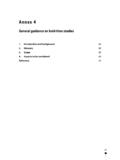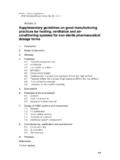Transcription of ICH M9 guideline on biopharmaceutics classification …
1 10 February 2020. EMA/CHMP/ICH/493213/2018. Committee for Medicinal Products for Human Use ICH M9 guideline on biopharmaceutics classification system-based biowaivers Step 5. Transmission to CHMP 25 July 2018. Adoption by CHMP for release for consultation 25 July 2018. Start of consultation 26 July 2018. Deadline for comments 26 January 2019. Final adoption by CHMP 30 January 2020. Date for coming into effect 30 July 2020. Official address Domenico Scarlattilaan 6 1083 HS Amsterdam The Netherlands Address for visits and deliveries Refer to Send us a question Go to Telephone +31 (0)88 781 6000 An agency of the European Union European Medicines Agency, 2020.
2 Reproduction is authorised provided the source is acknowledged. Document History Code History Date M9 Adopted by the Regulatory Members of the ICH 20 November 2019. Assembly under Step 4 (document dated 16. November 2019). M9 Endorsement by the Members of the ICH Assembly 7 June 2018. under Step 2 and release for public consultation (document dated 6 June 2018). ICH M9 guideline on biopharmaceutics classification system-based biowaivers EMA/CHMP/ICH/493213/2018 Page 2/18. ICH M9 on biopharmaceutics classification system-based biowaivers Table of contents 1.
3 Introduction .. 4. Background and objective .. 4. Scope .. 4. 2. biopharmaceutics classification of the drug substance .. 4. Solubility .. 5. Permeability .. 5. 3. Eligibility of a drug product for a BCS-based biowaiver .. 6. Excipients .. 7. In vitro 9. 4. Documentation .. 10. 5. Glossary .. 11. Annex I: Caco-2 cell permeability assay method considerations .. 12. Annex II: Further information on the assessment of excipient differences 15. ICH M9 on biopharmaceutics classification system-based biowaivers EMA/CHMP/ICH/493213/2018 Page 3/18.
4 1. Introduction Background and objective Two drug products containing the same drug substance(s) are considered bioequivalent if their bioavailabilities (rate and extent of drug absorption) after administration in the same molar dose lie within acceptable predefined limits . These limits are set to ensure comparable in vivo performance, , similarity in terms of safety and efficacy. In in vivo bioequivalence studies, the pivotal pharmacokinetic parameters AUC (area under the concentration time curve) and Cmax (maximum concentration), are generally used to assess the rate and extent of drug absorption.
5 The BCS ( biopharmaceutics classification System)-based biowaiver approach is intended to reduce the need for in vivo bioequivalence studies , it can provide a surrogate for in vivo bioequivalence. In vivo bioequivalence studies may be exempted if an assumption of equivalence in in vivo performance can be justified by satisfactory in vitro data. The BCS is a scientific approach based on the aqueous solubility and intestinal permeability characteristics of the drug substance(s). The BCS categorizes drug substances into one of four BCS classes as follows: Class I: high solubility, high permeability Class II: low solubility, high permeability Class III: high solubility, low permeability Class IV: low solubility, low permeability This guidance provides recommendations to support the biopharmaceutics classification of drug substances and the BCS-based biowaiver of bioequivalence studies for drug products.
6 The BCS-based biowaiver principles may be applied to bioequivalence purposes not explicitly specified in the guideline , provided they can be supported by a thorough scientific rationale. Scope BCS-based biowaivers may be used to substantiate in vivo bioequivalence. Examples include comparison between products used during clinical development through commercialization, post- approval changes, and applications for generic drug products in accordance with regional regulations. The BCS-based biowaiver is only applicable to immediate release, solid orally administered dosage forms or suspensions designed to deliver drug to the systemic circulation.
7 Drug products having a narrow therapeutic index are excluded from consideration for a BCS-based biowaiver in this guidance. Fixed-dose combination (FDC) products are eligible for a BCS-based biowaiver when all drug substances contained in the combination drug product meet the criteria as defined in sections 2 and 3. of this guidance. 2. biopharmaceutics classification of the drug substance BCS-based biowaivers are applicable to drug products where the drug substance(s) exhibit high solubility and, either high permeability (BCS Class I) or low permeability (BCS Class III).
8 A biowaiver is applicable when the drug substance(s) in test and reference products are identical. A. biowaiver may also be applicable if test and reference products contain different salts provided that both belong to BCS Class I (high solubility and high permeability). A biowaiver is not applicable when the test product contains a different ester, ether, isomer, mixture of isomers, complex or derivative of ICH M9 on biopharmaceutics classification system-based biowaivers EMA/CHMP/ICH/493213/2018 Page 4/18. a drug substance from that of the reference product, since these differences may lead to different bioavailabilities not deducible by means of experiments used in the BCS-based biowaiver concept.
9 Pro- drugs may be considered for a BCS-based biowaiver when absorbed as the pro-drug. Solubility A drug substance is classified as highly soluble if the highest single therapeutic dose is completely soluble in 250 ml or less of aqueous media over the pH range of at 37 1 C. In cases where the highest single therapeutic dose does not meet this criterion but the highest strength of the reference product is soluble under the aforementioned conditions, additional data should be submitted to justify the BCS-based biowaiver approach.
10 The sponsor is expected to establish experimentally the solubility of the drug substance over the pH. range of at 37 1 C. At least three pHs within this range, including buffers at pH , and , should be evaluated. In addition, solubility at the pH of lowest solubility of the drug substance should be evaluated if it is within the specified pH range. These experiments should demonstrate that solubility is maintained over relevant timeframes to accommodate the expected duration of absorption. Solubility should be evaluated by a method appropriate to the properties of the drug substance.













